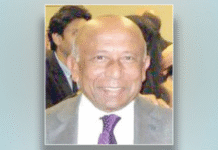Over the last year or so the executive and the legislative arms of the State appear to have geared up their disparagement of the higher judiciary. On several occasions the Chief Justice (CJ) has shared his anguish, among other issues, over separation of powers and independence of judiciary, the laxity of lawmakers in framing laws that hinder dispensation of justice and lack of cooperation of the executive branch in administering the lower judiciary. His remarks solicited uncharitable responses from certain quarters. The sculpture saga in the Supreme Court premises further complicated the relationship.
It all began in early May 2016 when the High Court (HC) in a landmark judgment, struck down the 16th Amendment to the Constitution, on grounds of being “unconstitutional”. Since then the strain between judiciary and the other two branches of the State became evident.
The amendment in question was related to the provision of removal of judges on grounds of incapacity or misconduct. The Court declared the amendment illegal and against the principles of the separation of state powers and the independence of judiciary and observed, “(t)he power of judging is, no doubt, a judicial power. This judicial power should not be given to the Parliament, a separate organ of the State”. It noted that such a move would constitute “an intrusion upon the independence of the Judiciary from the legislative organ of the State”, and would undermine the security of tenure of the judges. The Court further stated that the Supreme Judicial Council (that came into effect in 1978) was maintained even in Article 96 of the 15th Amendment. But subsequently, without apparent cause, the political executive made a volte face and got the 16th Amendment passed on strength of their more than two-thirds majority in Parliament, “without sufficiently reflecting upon the infringement of independence of Judiciary and its probable disastrous consequences undermining the confidence of the people on the administration of justice”. The Court viewed that the authority to remove the judges by members of Parliament would be like“(h)anging (the) Sword of Damocles over the heads of judges threatening their independence in discharging of judicial functions”.
The HC ruling triggered massive discontent among the MPs. The law minister observed, “(t)he judgment is against the Constitution”, claiming that the HC does not have the jurisdiction to deliver the verdict”. Several MPs felt that the ruling “undermined and humiliated parliament”. They termed the verdict as “a conspiracy against democracy and sovereign parliament” and warned that the lawmakers “would not tolerate any such plots”.
An influential MP suspected “conspiracy” behind the HC verdict and exhorted the government “to investigate if the judges concerned joined hands with any evil forces to destroy the country’s democracy and to make parliament nonfunctional”. Taking advantage of the parliamentary privilege the MP went on to advise the judges “not to do excesses” and expressed the hope that they (the judges) would “correct themselves”. He cautioned them against undermining “the sovereignty of parliament”. The vilest attack came from an influential minister. Pointing to a section of judges, he said, “(t)hey could become judges because we are in power.” Was the minister hinting that the time had come for the concerned judges to pay back the Piper?
It appears that the executive and the legislative organs of the State are yet to overcome the trauma of the termination of the 16th Amendment. In November 2016 the supervision of lower judiciary became yet another bone of contention between the executive and the judiciary. The issue flared up when the CJ pointed out that despite unequivocal stipulation of Article 109 of the Constitution empowering the HC to supervise and control all the subordinate courts, Article 116 “is one of the main reasons behind the sluggishness of the judiciary”. The CJ unreservedly stated that the dual role postulated in the existing Article 116 has been an impediment for the Supreme Court to effectively supervise promotions, transfers and disciplinary activities of the subordinate court judges and also in appointing judges in vacant posts in many districts. “It disrupts trials, leading to sufferings for people seeking justice” he noted. The top judge called for bringing back Section 116 as it was in the 1972 Constitution. It is a “demand of the time”, he observed.
In the 1972 Constitution the power of posting, promotion and grant of leave and discipline of persons employed in judicial service and magistrates exercising judicial functions was vested with the Supreme Court. However, under amended Article 116 those authorities shall “vest in the President and shall be exercised by him in consultation with the Supreme Court”.
The CJ’s plea for restoring unencumbered Supreme Court’s authority over lower judiciary drew sharp response from the law minister who found “no need” to bring about such change. Reinforcing his position the minister argued that the President is “the number 1 person of the State” and this “noble duty has been assigned to him”.
It may be worthwhile to note that as per Article 48 of the Constitution, except for appointing the Prime Minister and the Chief Justice (albeit as per relevant provisions of the Constitution on such appointments) the President, “shall act in accordance with the advice of the Prime Minister”. Thus, in effect, under current dispensation it would be the executive that has the final say in administering the lower judiciary.
Weeks ago, the CJ lamented, “Government was acting like a step mother to the judiciary”. The law minister disagreed. Terming the CJ’s statement “unfortunate” he advised the CJ “to communicate (his) concerns directly to executive rather than making them in public”. The minister observed, “chief justices in other countries do not talk much in public”. The CJ clarified, “it is the Supreme Court that can uphold independence of judges” and “since that is not maintained in Bangladesh, the chief justice has to speak out”.
The ruling Awami League’s all out effort to placate and bring on board obscurantist Hefazat-e-Islam has also taken its toll on the executive-judiciary relationship. Pressure has been exerted on the Supreme Court to address “public concerns” about the sculpture. The law minister concedes, “the CJ is the sole authority to decide on the matter”. If that were the case, why is the executive at all concerned about the sculpture’s fate?
The CJ’s expression of concern about absence of rule of law has also drawn ire from the ruling quarters. As the guardian of judiciary, isn’t the CJ spot-on in a situation where a magistrate is transferred within twenty four hours after she had passed an order of investigation against a powerful agency, hundreds of posts of magistrates and judges remain vacant, thousands remain incarcerated for years without being charged and tens of thousands of cases remain pending in the lower judiciary?
Source: The Daily Star









